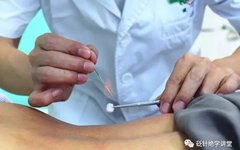Click on the “Mastery of Bian Needle Techniques” above to follow and receive methods for treating common diseases.
The operational procedures for “Fire Needle Therapy” are as follows. (1) Determining Acupoints: In addition to directly needling the local lesion, whether selecting meridian points or finding tender points, it is essential to mark the chosen acupoints with a thumb nail in a “十” shape before disinfection to ensure the accuracy of needling.(2) Disinfection: After determining the acupoints, first use a 2.5% iodine alcohol cotton ball to draw concentric circles around the acupoint, then use a 75% alcohol cotton ball to draw concentric circles to remove iodine. The procedure can be performed once the alcohol has dried.(3) Heating the Needle: Ignite the alcohol lamp and determine the length of the needle to be heated based on the depth of needling. The needle must be heated until it is red.
(1) Determining Acupoints: In addition to directly needling the local lesion, whether selecting meridian points or finding tender points, it is essential to mark the chosen acupoints with a thumb nail in a “十” shape before disinfection to ensure the accuracy of needling.(2) Disinfection: After determining the acupoints, first use a 2.5% iodine alcohol cotton ball to draw concentric circles around the acupoint, then use a 75% alcohol cotton ball to draw concentric circles to remove iodine. The procedure can be performed once the alcohol has dried.(3) Heating the Needle: Ignite the alcohol lamp and determine the length of the needle to be heated based on the depth of needling. The needle must be heated until it is red.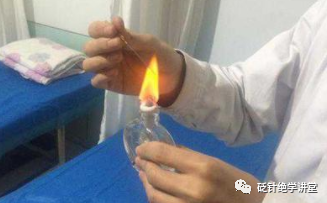 (4) Needle Insertion: When the needle is glowing red, quickly and accurately insert it into the acupoint and swiftly withdraw it. This process takes about 1/10 of a second.(5) Retaining the Needle: Primarily using fast needling, most cases do not retain the needle, while some require retention for 1 to 5 minutes. For treating painful diseases at distal acupoints, the needle should be retained for 5 minutes.(6) Needle Withdrawal: When withdrawing the needle, the practitioner should hold a disinfected dry cotton ball to wipe or press in case of bleeding or pus. When the fire needle reaches a certain depth, it should be withdrawn quickly to minimize patient discomfort and prevent enlarging the needle hole to avoid small scar formation.(7) Post-Needling Care: Generally, no special treatment is required after fire needle therapy; simply pressing the needle hole with a dry cotton ball is sufficient. This can alleviate pain and protect the needle hole.
(4) Needle Insertion: When the needle is glowing red, quickly and accurately insert it into the acupoint and swiftly withdraw it. This process takes about 1/10 of a second.(5) Retaining the Needle: Primarily using fast needling, most cases do not retain the needle, while some require retention for 1 to 5 minutes. For treating painful diseases at distal acupoints, the needle should be retained for 5 minutes.(6) Needle Withdrawal: When withdrawing the needle, the practitioner should hold a disinfected dry cotton ball to wipe or press in case of bleeding or pus. When the fire needle reaches a certain depth, it should be withdrawn quickly to minimize patient discomfort and prevent enlarging the needle hole to avoid small scar formation.(7) Post-Needling Care: Generally, no special treatment is required after fire needle therapy; simply pressing the needle hole with a dry cotton ball is sufficient. This can alleviate pain and protect the needle hole.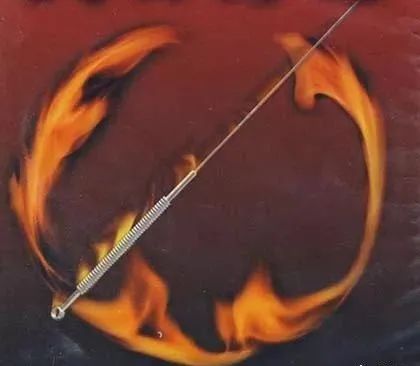 Needling Techniques of Fire Needle Therapy Based on Indications: Can be classified into meridian needling, tender point needling, dense needling, surrounding needling, and scattered needling.(1) Meridian Needling: Based on clinical manifestations and pattern differentiation, fire needles are applied at meridian points to warm the meridians, promote qi and blood circulation, strengthen the body’s resistance, expel pathogens, and adjust organ functions. This method is mainly suitable for internal diseases, using fine and medium fire needles. The depth of insertion is relatively shallower than that of fine needles.
Needling Techniques of Fire Needle Therapy Based on Indications: Can be classified into meridian needling, tender point needling, dense needling, surrounding needling, and scattered needling.(1) Meridian Needling: Based on clinical manifestations and pattern differentiation, fire needles are applied at meridian points to warm the meridians, promote qi and blood circulation, strengthen the body’s resistance, expel pathogens, and adjust organ functions. This method is mainly suitable for internal diseases, using fine and medium fire needles. The depth of insertion is relatively shallower than that of fine needles.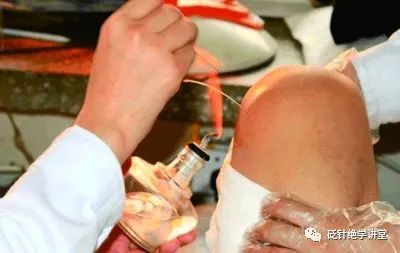 (2) Tender Point Needling: Locate the most prominent tender point at the lesion site and apply fire needle needling to ensure smooth flow of qi and blood in the local meridians. This method is suitable for muscle, joint, and various neural pains, primarily using medium fire needles, with deeper insertion as appropriate.(3) Dense Needling: This method uses medium fire needles to densely stimulate the local lesion area, with the density depending on the severity of the condition, with closer spacing for more severe cases, typically 1 cm apart. Sufficient heat is used to alter local qi and blood flow, promoting metabolism in damaged tissues. This method is mainly suitable for hyperplastic and keratinized skin conditions, such as neurodermatitis. Generally, medium fire needles are used, and the depth of needling should be moderate, ideally penetrating just through the diseased tissue and barely touching the normal tissue; too shallow or too deep is not advisable.
(2) Tender Point Needling: Locate the most prominent tender point at the lesion site and apply fire needle needling to ensure smooth flow of qi and blood in the local meridians. This method is suitable for muscle, joint, and various neural pains, primarily using medium fire needles, with deeper insertion as appropriate.(3) Dense Needling: This method uses medium fire needles to densely stimulate the local lesion area, with the density depending on the severity of the condition, with closer spacing for more severe cases, typically 1 cm apart. Sufficient heat is used to alter local qi and blood flow, promoting metabolism in damaged tissues. This method is mainly suitable for hyperplastic and keratinized skin conditions, such as neurodermatitis. Generally, medium fire needles are used, and the depth of needling should be moderate, ideally penetrating just through the diseased tissue and barely touching the normal tissue; too shallow or too deep is not advisable.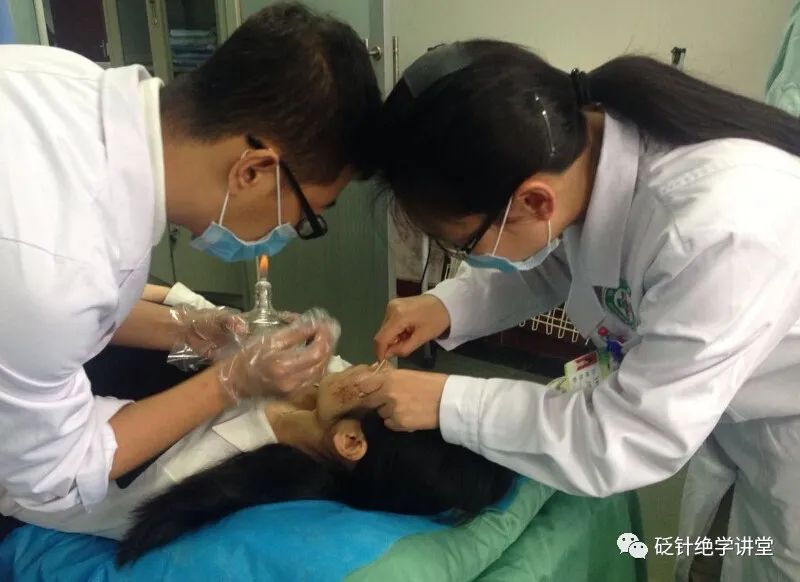 (4) Surrounding Needling: This fire needle technique involves needling around the lesion. The insertion points are primarily located at the junction of the lesion and normal tissue. Surrounding needling is mainly suitable for dermatological and surgical conditions, using medium fire needles, with a recommended spacing of 1 to 1.5 cm between needles. The depth of needling should be determined by the depth of the lesion; deeper lesions require deeper needling, while shallower lesions require shallower needling. Sometimes, direct needling to cause bleeding may be performed to remove stagnation, which is beneficial for local redness and swelling.(5) Scattered Needling: This technique involves loosely needling the lesion area with fire needles. It is effective for treating numbness, itching, spasms, and pain. Generally, needles are inserted every 1.5 cm. Fine fire needles are preferred, with shallower stimulation.Classification of Fire Needle Therapy Based on Insertion Speed: Can be divided into fast needling and slow needling.(1) Fast Needling: This is the most commonly used fire needle technique, characterized by rapid insertion and withdrawal. “Fire Needle Therapy” primarily employs fast needling. Generally, the needle is inserted and withdrawn swiftly without pause, taking only 1/10 of a second. The heat from the glowing needle stimulates the meridian qi, promoting qi and blood flow, and warming the meridians.“Fire Needle Therapy” primarily uses fast needling. The advantage of quick insertion and withdrawal is that it saves time and minimizes discomfort during treatment.
(4) Surrounding Needling: This fire needle technique involves needling around the lesion. The insertion points are primarily located at the junction of the lesion and normal tissue. Surrounding needling is mainly suitable for dermatological and surgical conditions, using medium fire needles, with a recommended spacing of 1 to 1.5 cm between needles. The depth of needling should be determined by the depth of the lesion; deeper lesions require deeper needling, while shallower lesions require shallower needling. Sometimes, direct needling to cause bleeding may be performed to remove stagnation, which is beneficial for local redness and swelling.(5) Scattered Needling: This technique involves loosely needling the lesion area with fire needles. It is effective for treating numbness, itching, spasms, and pain. Generally, needles are inserted every 1.5 cm. Fine fire needles are preferred, with shallower stimulation.Classification of Fire Needle Therapy Based on Insertion Speed: Can be divided into fast needling and slow needling.(1) Fast Needling: This is the most commonly used fire needle technique, characterized by rapid insertion and withdrawal. “Fire Needle Therapy” primarily employs fast needling. Generally, the needle is inserted and withdrawn swiftly without pause, taking only 1/10 of a second. The heat from the glowing needle stimulates the meridian qi, promoting qi and blood flow, and warming the meridians.“Fire Needle Therapy” primarily uses fast needling. The advantage of quick insertion and withdrawal is that it saves time and minimizes discomfort during treatment. (2) Slow Needling: After inserting the fire needle into the acupoint or area, it is retained for a short period before withdrawal. The retention time is generally 1 to 5 minutes. During the retention period, various tonifying and draining techniques can be applied. Slow needling is effective for expelling necrotic tissue, draining pus, and dispersing masses. It is mainly suitable for conditions such as lymphatic tuberculosis, tumors, cysts, and various diseases involving necrotic tissue and abnormal hyperplasia.
(2) Slow Needling: After inserting the fire needle into the acupoint or area, it is retained for a short period before withdrawal. The retention time is generally 1 to 5 minutes. During the retention period, various tonifying and draining techniques can be applied. Slow needling is effective for expelling necrotic tissue, draining pus, and dispersing masses. It is mainly suitable for conditions such as lymphatic tuberculosis, tumors, cysts, and various diseases involving necrotic tissue and abnormal hyperplasia.
Long press to recognize the QR code below to make an appointment for learning!!
Please share this article to let more people see it.
Promote Traditional Chinese Medicine culture
Spread TCM knowledge
Let’s practice together!

